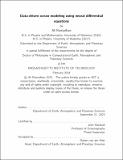Data-driven ocean modeling using neural diferential equations
Author(s)
Ramadhan, Ali
DownloadThesis PDF (10.27Mb)
Advisor
Marshall, John
Terms of use
Metadata
Show full item recordAbstract
Even with today’s immense computational resources, climate models cannot resolve every cloud in the atmosphere or eddying swirl in the ocean. However, collectively these small-scale turbulent processes play a key role in setting Earth’s climate. Climate models attempt to represent unresolved scales via surrogate models known as parameterizations. However, these parameterizations have limited fdelity and can exhibit structural defciencies. In this thesis, we attempt to develop new data-driven parameterizations of oceanic turbulence with better predictive skill than the existing operational parameterizations. First we develop Oceananigans.jl, a next-generation, fast, and friendly ocean model that runs on CPUs and GPUs to be able to generate the high-resolution simulation data needed to train the parameterizations (and simulate some other fows at high resolution along the way). We describe in detail the equations being solved and the numerical methods employed by Oceananigans.jl, as well as some validation test cases and selected research results that Oceananigans.jl made possible. We then demonstrate that neural networks embedded in the partial diferential equations of fuid dynamics may be trained on highly resolved fuid-dynamical models of unresolved scales and act as data-driven parameterizations in an ocean model. These neural networks overcome limitations of traditional neural networks in fuid dynamical applications in that they can incorporate conservation laws and are stable when integrated for long times. We argue that our approach provides a new route forward to the development of surrogate models for climate science, opening up exciting new opportunities. We then end by transferring the trained neural networks into a hydrostatic large-scale ocean model.
Date issued
2024-02Department
Massachusetts Institute of Technology. Department of Earth, Atmospheric, and Planetary SciencesPublisher
Massachusetts Institute of Technology